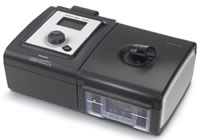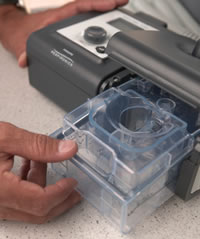Product Premiere
Flexible Therapy
Philips Respironics’ new Sleep Therapy System offers a range of options.
- By David Kopf
- Nov 01, 2009
Providing therapy for patients with obstructive sleep apnea (OSA) presents a mix of challenges, including ensuring patient compliance, providing the proper DME, and adapting to patient’s changing therapy needs.
Between 18 million and 20 million Americans suffer from OSA, according to the National Sleep Foundation. Left untreated OSA can increase the risk of high blood pressure, diabetes, heart attack and stroke, according to the U.S. Department of Health and Human Services. However, the severity in patient conditions can range from mild to pronounced.
Bearing that in mind, Philips Respironics recently unveiled its Sleep Therapy Systems at Medtrade Fall last month in Atlanta, Ga. The goal is to provide a single platform that can deliver a range of therapy options to treat mild to severe sleep conditions.

The new Sleep Therapy Systemincorporates Philips Respironics’ Flex Familyof airway pressure technologies, as well as remotereporting and event detection capabilities.
All in the Family
To begin with the new system incorporates Philips Respironics’ Flex family of airway pressure technologies. Over the years, the company has released various enhancements to this family, including its C-Flex, Bi-Flex, A-Flex and C-Flex+ in its fixed-CPAP units. These technologies leverage the company’s Digital Auto-Trak algorithm to detect the onset of inspiration and expiration in order to provide the right amount of pressure at the right time:
C-Flex provides flow-based pressure relief at the beginning of exhalation and adjusts as needed on a breath-by-breath basis, with the level of pressure relief based on the patient’s expiratory flow and one of three patient-selected CFlex settings.
Bi-Flex offers pressure relief at inhalation and exhalation to help BiPAP therapy feel more like regular breathing. Bi-Flex tracks each breath to deliver pressure relief at the transition from exhalation to inhalation; the transition from inhalation to exhalation; and during exhalation.
A-Flex works with Philips Respironics’ auto-CPAP algorithm to match pressure delivery to the patient’s entire breathing cycle. It provides flowbased pressure relief at the beginning of exhalation, and softens the pressure transition from inhalation to exhalation to provide additional comfort in auto-CPAP mode. The pressure profile mirrors patient breathing and responds to his or her therapeutic needs while the patient sleeps. C-Flex+, the latest release, is used in fixed CPAP mode to provide flow-based pressure relief at the beginning of exhalation and soften the pressure transition from inhalation to exhalation. To help demonstrate the benefits of these technologies, the new system features an onboard Flex demo mode that lets patients experience the Flex technology firsthand.
Humidity and Resistance Control
Another factor in patient compliance and reducing support calls to the provider is ensuring sleep therapy devices provide optimal humidity level. Philips Respironics new system integrates what it calls System One Humidity Control to help patients ensure they have a consistent humidity level.
Patients select one of five settings to ensure the relative humidity at the mask is comfortable for them. System One monitors the room temperature, room humidity and flow in order to adapt to changing environmental conditions, and maintain the patient’s desired humidity level.
Controlling humidity output at the mask also helps the system prevent rainout. Rainout occurs when water vapor condenses in the tube and mask, and the air-flow blows the water into the patient’s face. (Obviously, that’s the last thing an OSA patient needs when trying to get a solid, uninterrupted night’s sleep.)

The Sleep Therapy System’s water chamber, combinedwith a “dry box” act as a two-stage defense againstwater ingress into the unit.
To help prevent water ingress, the system incorporates a two-step approach: To begin with the system’s water chamber is designed in such a way that, even when filled to the “full” mark, the system can be tilted or even turned upside-down and water will not leak back into the unit. Moreover, if any water were to escape from the chamber, a Dry Box that goes between the water chamber and the unit acts a sort of airlock to prevent the water from entering the system.
Additionally, the system also provides System One Resistance Control, which adjusts pressure delivery to optimize how the unit works with a mask. A different mask can skew the air-flow performance of the device so client or caregiver can enter the mask that is being used into the system, and System One will compensate with its air-flow.
Patient Management
The system leverages the Encore patient management system to provide access to timely patient data. The system lets physicians review patient data either using a web-based system called Encore Anywhere or a desktop system called Encore Pro.
Encore Anywhere uses a wireless connection or wired modem that lets the system upload data that physicians, sleep lab processionals and homecare providers can access via a secure website. This way care professionals can view timely patient data, share information, collaborate and, if necessary change prescriptions.
Using Encore Pro, physicians can access the data using an SD card (like those used in digital cameras and other electronics) with the desktop software and access and use the data using the same sorts of reporting tools.
The system records all of a patient’s data as he or she sleeps and highlights any events that might require intervention. Then reporting tools can help summarize and prioritize various patient needs for the physician in case a change in therapy is needed.
Internal memory on each Sleep Therapy System device stores six months of compliance data and the five most recent days of flow waveforms. which can be transferred via the wireless or wired connection, or via an SD card.
Event Detection
Sleep patients can experience various respiratory events during sleep, and some can be serious. Philips Respironics’ new system uses an event detection algorithm to detect and distinguish between various respiratory events, and alert when more advanced therapy might be needed. For instance, the system can detect when a condition such as Cheyne-Stokes breathing exists and helps the patient’s caregivers identify any possible comorbidities sooner, rather than later.
Or, if the device detects that an apnea has occurred it can determine if the patient’s airway was open or closed After several seconds of significant flow reduction, the device will sent test pressure pulses. If there is a significant amount of flow, then it will report the apnea as a clear way apnea.
All told, the Sleep Therapy System detects up to eight different kinds of events: periodic breathing, clear airway apnea, obstructed airway apnea, hypopnea, RERA, flow limitation, vibratory snore and a large leak.
This data is reviewed by caregivers in a Patient Flow & Event report in the Encore system that not only delivers the patient’s data, but uses color-coded highlighting to help care professionals more easily view these events, as well.
The Device Itself
The system’s size is about that of a clock radio, measuring 7 in. long, by 5.5 in. wide by 4 in. high. The device is controlled via a click dial that functions somewhat like the click wheel on an iPod. Users rotate and click the knob to select various options on an LCD panel above the dial.
The new devices include basic, compliance and auto-adjusting models. Accessories include power supplies, a carrying case, power cord, filter kit and integrated humidifier. The Sleep Therapy System comes with a two-year, replace-with-new warranty, as well as Philips Respironics’ service and support.
Philips Respironics
(800) 821-2710, ext 245
www.respironics.com
This article originally appeared in the November 2009 issue of HME Business.